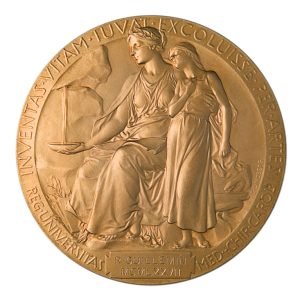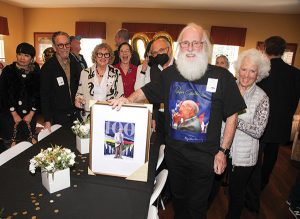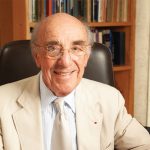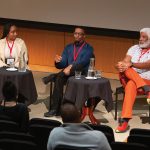In Memoriam Salk mourns the loss of Nobel Laureate Roger Guillemin
Salk Distinguished Professor Emeritus Roger Guillemin, recipient of the 1977 Nobel Prize in Physiology or Medicine and neuroendocrinology pioneer, died on February 21, 2024, in Del Mar, California, at the age of 100.
The neuroendocrinology pioneer was a treasured member of the Salk community, deeply appreciated both for his many achievements and for his loyal friendship and mentorship, even after retirement.
“We are deeply saddened by Roger’s passing,” says Salk President Gerald Joyce. “But I’m glad many of us had the chance to celebrate his 100th birthday with him earlier this year. It was an honor to have known one of the world’s preeminent scientists and someone who also was one of the kindest persons I’ve met. Roger leaves a remarkable legacy at Salk and around the world. His brilliance, commitment, and passion for discovery brought forth some of the last century’s most significant advances in our knowledge of the human brain. He was a cherished colleague and mentor to many. I know that generations from now we will still be talking about his contributions to science and humanity.”
Guillemin’s time at Salk and Nobel Prize
Considered the founder of the field of neuroendocrinology, Guillemin’s pioneering research into brain hormones has led to treatments for disorders ranging from infertility to pituitary tumors.
When Guillemin joined Salk in 1970, he headed the newly established Laboratories for Neuroendocrinology. He and his group discovered somatostatin, which regulates the activities of the pituitary gland and the pancreas. Somatostatin is used clinically to treat pituitary tumors. He was among the first to isolate endorphins—brain molecules that act as natural opiates—and his work with cellular growth factors led to the recognition of multiple physiological functions and developmental mechanisms.

Guillemin played a key part in discovering the brain’s role in regulating hormones—molecules that act as chemical messengers between different parts of the body and regulate bodily functions. While scientists had long believed that the brain ultimately controlled the function of hormone-producing endocrine glands, there had been scant evidence to prove exactly how it did so.
After meticulous study of materials harvested from 1.5 million sheep brains, Guillemin and his team made a breakthrough. They discovered releasing hormones, produced in small quantities in the hypothalamus of the brain. These are delivered to the adjacent pituitary gland, which in turn is triggered to release its own hormones that are dispersed through the body. Guillemin and Andrew Schally separately extracted a sufficient amount of one releasing hormone to determine its structure in 1969. They subsequently were able to produce it with chemical methods.
Their work would lead them to the 1977 Nobel Prize in Physiology or Medicine, shared also with Rosalyn Yalow for a separate but related discovery, for “discoveries concerning the peptide hormone production of the brain.”
This breakthrough resulted in the identification of a molecule called TRH (thyrotropin-releasing hormone), which ultimately controls all the functions of the thyroid gland. In the following years, Guillemin and his colleagues isolated other molecules from the hypothalamus that control all functions of the pituitary gland—for instance, GnRH (gonadotropin-releasing hormone), a hypothalamic hormone that causes the pituitary to release gonadotropins, which in turn trigger the release of hormones from the testicles or ovaries.
This discovery led to advancements in the medical treatment of infertility and is also used to treat
prostate cancer.
Though Guillemin retired from the lab in 1989, he remained active at Salk throughout the following years. He shifted his long-standing expertise with computers from science to art and was one of the pioneers in the expanding field of digital paintings.
In 2007, Guillemin was gracious enough to serve a term as interim president of the Salk Institute, saying, “By all criteria, the Salk Institute is one of the most prestigious biological research institutions of the country and in the world.”
Prior to the COVID-19 pandemic, Guillemin kept regular office hours at the Institute, continuing to provide his time and experience to any who might seek his council.
“I really wanted to be a physician… [and] I knew all my efforts would be to help people.”
–Roger Guillemin

Path to science and Salk
Born in Dijon, the capital of France’s Burgundy region, Guillemin gained an early interest in science. As a child, he collected organisms, including mushrooms, for classification. He was also good with his hands, using his dexterity and intellect to build radios and transmitters. After attending public schools, he entered medical school at the Université de Bourgogne in 1943.
Guillemin’s youth and college experience was wrought with challenges—most considerable of which was the German occupation of France. During his first year of medical school, he and several of his classmates received orders to report to Munich to build weapons for the German army, but they refused.
“We all tore the thing up and said, ‘We’re going to disappear in the Underground,’” Guillemin said in a 2013 video, where he reminisced about his scientific accomplishments.
Guillemin went on to earn his MD in 1949 and practiced medicine for several years before committing to research full time. He earned his PhD in physiology, with a special focus on experimental endocrinology, from Université de Montréal in 1953. Shortly after completing his PhD, Guillemin became an assistant professor of physiology at the Baylor University College of Medicine.
In addition to the 1977 Nobel Prize, Guillemin received numerous accolades for his work. These included the Gairdner International Award, the Dickson Prize, the Passano Award, the Lasker Award, and the President’s National Medal of Science, presented to him by then-President Jimmy Carter. He was also an elected member of the National Academy of Sciences (1974) and the American Academy of Arts and Sciences (1976). Guillemin’s native France recognized his contributions to science and health by naming him a Commander in the Legion of Honour, the country’s highest order of merit.
Helping people
Guillemin was a mentor to many future leaders in endocrinology and medical research while at Baylor, including Catherine and Jean Rivier, as well as Wylie Vale, who would all follow Guillemin to Salk in 1970 and join the faculty there.
For all of his accomplishments, Guillemin was always quick to point out the contributions of the many people who worked alongside him. “I have had the extraordinary privilege to work with wonderful collaborators, some so much more knowledgeable in their own field than I was (or still am), all full of enthusiasm and sharing the common ethics of science,” he wrote as he reflected on achieving the Nobel Prize.

When asked in a September 2017 interview with the La Jolla Light what his philosophy in life was, Guillemin responded, “Help people. I really wanted to be a physician… [and] I knew all my efforts would be to help people.”
Up until his last few years of life, Guillemin was an active member of the La Jolla, California, community and was an avid collector of French and American paintings and sculptures, as well as Papuan and pre-Columbian pottery.
Guillemin is survived by his five daughters, one son, four grandchildren, and two great-grandchildren. He was predeceased by his wife, Lucienne, a talented musician, who died at the age of 100 in 2021, after the couple was married for 69 years. Guillemin died on her birthday.
Birthday well-wishes from colleagues

In January, Guillemin turned 100, and at that time several of his colleagues showed their appreciation for him. Here are some of their sentiments from that occasion:
“Roger has had a very big influence on my scientific and personal life,” said Salk Professor Rusty Gage, past president of Salk. “His own contributions to science are enormous, but in addition, he has been so supportive and generous with his encouragement and advice to me and many other scientists whose lives he has touched. Importantly, he is a model for fostering the care and love of family, as reflected in his loving relationship with his late wife, Lucienne, and his remarkable children, including the wonderful Claire. I am proud to count Roger as a dear friend, colleague, and mentor.”
“Roger has always been a personal inspiration,” said Salk Professor Greg Lemke. “His curiosity to understand the brain’s regulation of physiology, which was unrelenting, led to discoveries that have impacted the lives of millions.”
“I’ve known Roger for 45 years now, and he is truly a trusted colleague, a good friend, and an inspirational mentor,” said Salk Professor Ronald Evans. “His pioneering discoveries of hypothalamic peptides launched the field of neuroendocrinology.”
“Even before my arrival at the Salk Institute as a postdoctoral researcher in 1971, Roger had established himself as a preeminent scientist,” said Salk Professor Tony Hunter. “A few months later, his group announced their historic discovery of the somatostatin neuropeptide that blocks growth hormone release, creating huge excitement— deservedly so. Over the years, Roger has been a great inspiration to me, and his discovery of somatostatin was an example of the type of groundbreaking research that has become the hallmark of the Institute. It’s an honor to celebrate his truly amazing life of science and art.”
[ssba]
Support a legacy where cures begin.
Featured Stories
 Interaction + Infrastructure = Innovations in Healthy AgingSalk formula recalculates aging research, shifting focus to overall resilience and health span.
Interaction + Infrastructure = Innovations in Healthy AgingSalk formula recalculates aging research, shifting focus to overall resilience and health span. Salk mourns the loss of Nobel Laureate Roger GuilleminThe Institute remembers the “father of neuroendocrinology” for his many contributions to science and friendship to all.
Salk mourns the loss of Nobel Laureate Roger GuilleminThe Institute remembers the “father of neuroendocrinology” for his many contributions to science and friendship to all. Professor Jan Karlseder named Salk’s Chief Science OfficerOn February 1, Jan Karlseder started as Salk’s new senior vice president and chief science officer (CSO).
Professor Jan Karlseder named Salk’s Chief Science OfficerOn February 1, Jan Karlseder started as Salk’s new senior vice president and chief science officer (CSO).  Daniel Hollern–Turning a cancer diagnosis into a career in basic researchAssistant Professor Daniel Hollern pivoted his career trajectory after a family member’s life-changing diagnosis pushed his already-curious mind off a cliff of questions—starting with, “What can I do to help him?”
Daniel Hollern–Turning a cancer diagnosis into a career in basic researchAssistant Professor Daniel Hollern pivoted his career trajectory after a family member’s life-changing diagnosis pushed his already-curious mind off a cliff of questions—starting with, “What can I do to help him?” Jerry Sheehan–Collaborating shoulder to shoulder with scientistsWhen you think about a person who heads an information technology department, you might not envision them working shoulder to shoulder with research scientists. But that’s exactly the approach Jerry Sheehan is taking as Salk’s new chief information officer (CIO).
Jerry Sheehan–Collaborating shoulder to shoulder with scientistsWhen you think about a person who heads an information technology department, you might not envision them working shoulder to shoulder with research scientists. But that’s exactly the approach Jerry Sheehan is taking as Salk’s new chief information officer (CIO). Laura Mainz–Taking control after a cancer diagnosisLaura Mainz grew up in a tiny village in midwestern Germany, with just as many cows as people. But the sweeping landscape speckled with farms never swayed her toward plant biology—instead, her interest in the human body grew.
Laura Mainz–Taking control after a cancer diagnosisLaura Mainz grew up in a tiny village in midwestern Germany, with just as many cows as people. But the sweeping landscape speckled with farms never swayed her toward plant biology—instead, her interest in the human body grew. Black Association affinity group cultivates welcoming environmentThe Black Association at Salk (BAS) was one of the first affinity groups formed at Salk in 2020. Since that time, it has established itself as a welcoming space and go-to for resources for all Black Salk community members.
Black Association affinity group cultivates welcoming environmentThe Black Association at Salk (BAS) was one of the first affinity groups formed at Salk in 2020. Since that time, it has established itself as a welcoming space and go-to for resources for all Black Salk community members.




















































